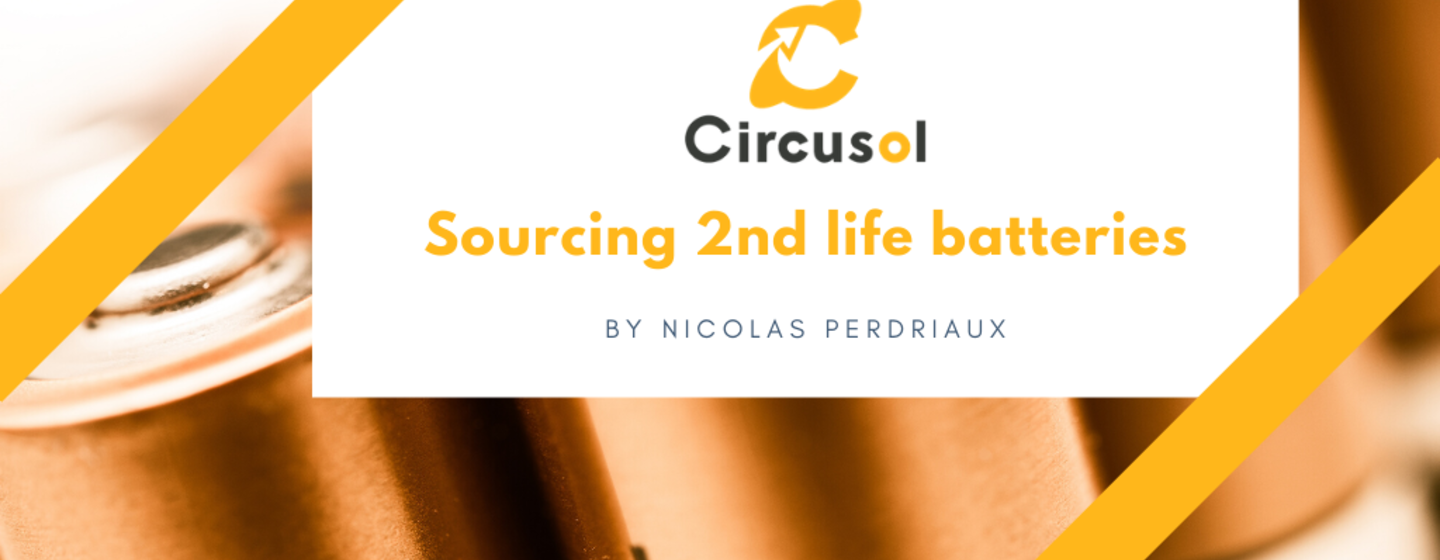
CIRCUSOL: Solar power business models towards a circular economy in Europe (PRESS RELEASE)
CIRCUSOL: Solar power business models towards a circular economy in…

Second-life batteries are coming from end-of-life (EoL) traction batteries of electric vehicles (EV) (either fully electric or hybrid). They are very dense energetically even when they reach the end of their first life which is a boon because they can be turned towards less-energy demanding applications but also a curse in that they are, intrinsically, risk-heavy contraptions. Thus, how do the companies that are in the second-life batteries supply chain deal with that? We will be focusing on three main type of companies, all along the supply chain, and mainly in Europe, as it can differ greatly from continent to continent.
As we are talking here about EV batteries and as there is some value left (and a legal obligation to do so through the Extended Producer Responsibility, EPR), carmakers have been organizing themselves to collect them and have them taken care of. We need to digress a bit here to say that the 2nd-life model is just being developed but already is seeing some competition in the form of less technology demanding models like repair (change the failing modules in the battery to give it a continued first-life) and 2nd use (the battery is checked for anomalies and according to its State of Health, used in relevant applications).
Some of the Original Equipment Manufacturer (OEM) have decided though, at least for the second-life-able part of their EoL batteries, not to mix them with their recyclable batteries and keep them for internal use only. This kind of captive batteries is then used in a public demonstration of their capacity to remanufacture their own batteries and to showcase the battery as a whole, including the first-life capacity and thus the vehicle containing it. The fact that it promotes good environmental change is an added bonus, once again because it reinforces the position of their EV vehicle in the segment. We can see for example Renault with its failing ELSA experiment, or the focus put by BMW on reusing its i3 batteries or the numerous small tests of 2nd-life stationary storage done by Nissan and its partnership with Eaton.
For the companies who have decided to work with a recycler for dealing with their EoL batteries, it is much simpler as the recycler will take care of most of the administrative duty. There are a lot of them to be cleared and even if some of them are supranational (as for example the ADR Treaty), others can be national when relative to wastes and their crossing of borders etc. Once those duties are cleared (it can take some time when there is a new client or a new type of batteries), it’s then another set of problem for the company in the middle (currently most of the times a recycler, but it is branching out as full-fledged remanufacturing companies in Europe, as in Asia it’s already being vertically integrated). Aside from the commercial discussions that need to happen between the OEM and the company regarding the valorization of the waste, the transfer of responsibility for the EPR is still a grey area, at least in Europe, which is why carmakers are allying themselves with recyclers as they are the one that can clear them of their EPR.
Those intermediate companies can also set up their own subsidiary which will be in charge of exploitation and distribution of the final products, especially in the case where the intermediate company is an ex-nihilo creation or a branch-off as specific installations can be dedicated to this task.
In the case where the intermediate company doesn’t want to directly sell to businesses or individuals, it can then form marketing contracts with distributors of energy storage solutions. However in both cases, the newly-created 2nd-life batteries still have to pass a plethora of regulations and rulings, and not just once, but for each subdivision of the battery pack/cabinet (module, pack, full cabinet) and depending on the location of the sale abide by national laws if they are stricter. The most known would be the UN38.3 transport guidance, electro-magnetic certification (e.g. in France NF-EN-61000 or NF-EN-62311), safety certification (e.g. again in France NF-EN-62619), etc. Also depending on the final destination of the 2nd-life battery, further design improvements must be done when dealing with individuals, as the majority of the accidents having happened involving battery energy storage were by the unsafe intervention of an individual in their house. This is why partnering with an already established energy storage distributor is very advantageous as they have experience and know-how. A final constraint for the remanufacturing company would be that now they must abide by the EPR themselves and thus provision for the end-of-life of their 2nd-life batteries.
In Europe, getting your hands on EoL lithium-ion batteries can be a long journey, and as not every EoL battery is 2nd-life-able – that is one thing that we did not discuss here, as there is a technological hurdle of diagnosing an EoL battery if you don’t have the cooperation of the OEM – you need to have contingency plans. And in the end, when you actually remanufacture those batteries into 2nd-life batteries, the actual exploitation is as stringent as for a fresh battery (even though things are moving with for example the UL1974, which defines a protocol for assessing EoL batteries for an easier, further down the line, certification). But as the market for EV is exploding and the environmental public conscience growing larger and larger, the need for energy storage will be higher and higher and 2nd-life batteries will meet a lot of requirements.
Nicolas Perdriaux is a Projects Economic Assistant who holds a Master in Supply Chain Management and has been employed at SNAM since 2017. His main activities include financial controlling and administrative support for the European and national projects in which SNAM is involved. He also works in the accounting department on controlling activities. His transversal activities allow him to be in contact with every other department to keep in touch with the latest developments in Operations and R&D.
SNAM is a European player in the collection and recycling of batteries, born from the metallurgical industry in 1981. SNAM is the ideal partner for large international companies for the treatment of their waste containing heavy metals. The company provides the best available technologies that enable it to be one of the few companies in the world to master metal recovery techniques (Cd, Li, Ni...).
SNAM’s main roles in the project are to supply remanufactured batteries electric vehicles, to lead cost and application analysis for second-life batteries, and to support CEA in developing labelling/certification protocol.

CIRCUSOL: Solar power business models towards a circular economy in…